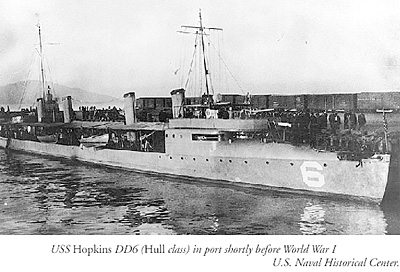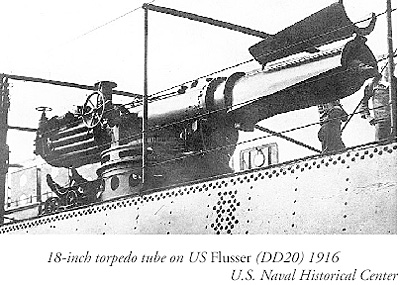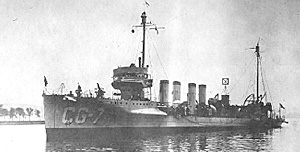 Unlike its Spanish foe, The United
States Navy fought the Spanish-American
War without a destroyer class, then
known as “torpedo-boat destroyers.”
Unlike its Spanish foe, The United
States Navy fought the Spanish-American
War without a destroyer class, then
known as “torpedo-boat destroyers.”
USS Hopkins DD6 (Hull class)in port shortly before World War I
Although the US Navy easily prevailed, its officers had seen a significant threat from Admiral Cerveras' British-built destroyers of the Furor and Audaz classes. Theodore Roosevelt, before and after he became President, was a strong advocate of destroyers, and no less than twenty-six destroyers had been authorized by the time his term ended.
The first sixteen US destroyers were authorized by Congress on 4 May 1898, before the end of the Spanish American War, and entered service between 1902 and 1903. Though often considered as one class (Bainbridge or “400 tonners”), their armament, displacement and speed varied depending on the builder, and they actually consisted of at least four distinctive types.
DD1-DD5 and DD10-DD13 were built to official plans, while DD6-DD7, DD8-DD9 and DD14-DD16 were built to the builder's plans. The DD8-DD9 class was unsuccessful and could not carry 3-inch guns, which were removed and replaced by 6-pounders.
New destroyer construction was not authorized until June 1906 when the first three ships of the Smith class were ordered.
As the Bainbridge classes had come out overweight and somewhat fragile and failed to meet their design speed of 30 knots, the new destroyers were much larger and designed to be ocean-going. DD17 Smith was the first US turbine-powered destroyer and DD24 Roe of the later Paulding class was the first US destroyer to be entirely oil-fueled.The Smith, Paulding and Monaghan classes, or “700 tonners," built between 1908 and 1912, eventually became known as “flivvers" when later, even larger destroyers were built.
{Ed note: A “flivver" was WW I slang for a jalopy -- a cheap, small, and usually old car}.
The “flivvers” standardized on a main armament of the 3-inch/50 caliber gun with three sets of twin torpedo tubes.
Although the “flivvers" were a success, the Navy wanted even bigger, more heavily armed destroyers.Thus, the next class of destroyers was designed to displace 1,000 tons with 4-inch guns and, except for the Cassin class, 21-inch torpedo tubes.These “1000 tonners” composed two classes and were built between 1912 and 1917. Antiaircraft weapons appeared in the Sampson class in the form of two 1-pounder pom-pom guns.
 18-inch torpedo tube on US Flusser (DD20) 1916 (U.S. Naval Historical Center)
18-inch torpedo tube on US Flusser (DD20) 1916 (U.S. Naval Historical Center)
Even before the “1000 tonners” had entered service, the Navy was designing its next-generation destroyer.Destroyer officers demanded more speed and an even heavier torpedo armament. Better sea-keeping ability was also wanted. As the Navy lacked the numerous light cruisers found in the British and German navies, its destroyers would have to act as scouts, posted ahead of the Battle Fleet to warn of the approach of enemy forces. Thus, in 1916 the prototype of the famous “flush-deckers" was born, which served in both World Wars.
Six new destroyers were ordered in 1916, rated at 30 knots and with a flush deck instead of the raised forecastle of previous US destroyers. These ships, the Caldwell class, were armed, like the “1000 tonners," with 4-inch guns, and had no less than four sets of 21-inch triple torpedo tubes.
The entry of the United States into World War I on 6 April 1917 triggered a massive expansion of the Navy and a desperate need for destroyers to combat the U-Boat menace and protect the fleet. A huge destroyer force had to be constructed as rapidly as possible in as many shipyards as could be found or built. The design of the Caldwell class was selected as the basis of all war-time destroyer construction and was modified, first, for an increased speed of 35 knots, and, second, to carry more fuel for an wider radius of operation.
All were built to either of two basic designs. The Bath Iron Works design was known informally as the “Liberty" type and ultimately as the Wickes class.The Bethlehem Steel design, with greater fuel capacity, was known as the Clemson class. Both types were armed as the Caldwell class, but the original antiaircraft armament was modified and later reduced in favor of more ASW capability in the shape of a Y-gun.
Reports of German destroyers that were to mount 5.9-inch guns resulted in the Clemsons being given stronger gun foundations to be able to carry 5-inch/51 caliber guns.However, only five ships ever received the heavier guns. Three of the class were fitted with 4-inch guns in twin mounts.
Wartime destroyers were built both in Navy Yards and in private shipyards, including the Navy Destroyer Plant at Squantum, Massachusetts, and the Clemson class was designed to be built using mass production techniques. With the urgent need for destroyers, the ships were built as fast as possible, but it still took eight to ten months to construct, although Mare Island Navy Yard commissioned DD 139 Ward seventy days after she was laid down.Together with the prototype Caldwell class, the Wickes and Clemson classes were known as “flush deckers.” Ultimately, 273 were built (only six of the Wickes class were cancelled).
Nevertheless, the brunt of overseas destroyer service was borne by the prewar designs, and they were sent first to Great Britain where they operated from England and Ireland.
The first US Navy ships to arrive in the war zone were six destroyers, commanded Commander Joseph K.Taussig, which reported for duty to the senior British officer at Queenstown after opening sealed orders at sea on 24 April 1917. Thereafter destroyers were sent to the Mediterranean and to France. Those remaining in the United States were used to escort convoys.
Their main enemy was the U-Boat. Endless convoy duty and patrolling produced claims of submarines sunk or damaged, but only one German U-Boat fell victim to US destroyers: U-58 on 17 November 1917 by DD37 Fanning and DD52 Nicholson. Only two were lost, one to a U-Boat and one to a collision. All classes of destroyers were equipped with basic anti-submarine weapons, including depth charges, and Y-gun depth charge launchers for the “flush deckers".
Additional ASW armament notes for all classes :
- The first ASW weapons were 2 DC in slings at the stern.
- From April 1918: 2 Mk1 DC rail w/8 DC, later w/13. Total DC capacity: Bainbridge class, 68; all other classes, 80 charges.
 USCGC Porter (Tucker class, ex-DD-59) circa 1924-30, while operating to support the enforcement of Prohibition laws as a unit of the U.S.Coast Guard. Note what appears to be a large radio direction finder amidships. (U.S.Naval Historical Center.)
USCGC Porter (Tucker class, ex-DD-59) circa 1924-30, while operating to support the enforcement of Prohibition laws as a unit of the U.S.Coast Guard. Note what appears to be a large radio direction finder amidships. (U.S.Naval Historical Center.)
After the end of the war, the “flush-deckers" remaining under construction were completed at a more leisurely pace, with the last one being commissioned on 9 August 1922. The Bainbridge and Smith classes all went to the breakers in 1919. Some of the “flivvers" and “1000 tonners" gained a reprieve by being transferred to the Coast Guard to chase down rum runners and smugglers during Prohibition.
The vast number of flush deckers meant, in part, that there would be no new US destroyers laid down until 1932. When the United States entered World War II, some 118 flush deckers remained in service, plus one lone surviving “1000 tonner" of the Sampson class.One hundred and four had been lost or scrapped between the wars, and fifty transferred to Great Britain under the famous “Destroyers for Bases" deal in September 1940.
Bibliography
Campbell, John. Naval Weapons of World War Two. London: Conway Maritime Press, 1985
Canney, Donald L. U. S. Coast Guard and Revenue Cutters. 1790-1935, Annapolis: Naval Institute Press, 1995
Dictionary of American Naval Fighting Ships . online version: http://www.hazegray.org/danfs/
Friedman, Norman. U. S. Destroyers An Illustrated Design History. Annapolis: Naval Institute Press, 1982
Gardiner, Robert, ed. Conway’s All the World ’s Fighting Ships 1860-1905 . Annapolis: Naval Institute Press, 2002 edition
Gardiner, Robert, ed. Conway’s All the World ’s Fighting Ships 1906-1921 . Annapolis: Naval Institute Press, 2002 edition
Silverstone, Paul H. U. S. Warships of World War I. Garden City NY: Doubleday and Company, Inc., 1970
BT
Back to The Naval Sitrep # 27 Table of Contents
Back to Naval Sitrep List of Issues
Back to MagWeb Master Magazine List
& copy Copyright 2004 by Larry Bond and Clash of Arms.
This article appears in MagWeb.com (Magazine Web) on the Internet World Wide Web.
Other military history and related articles are available at http://www.magweb.com